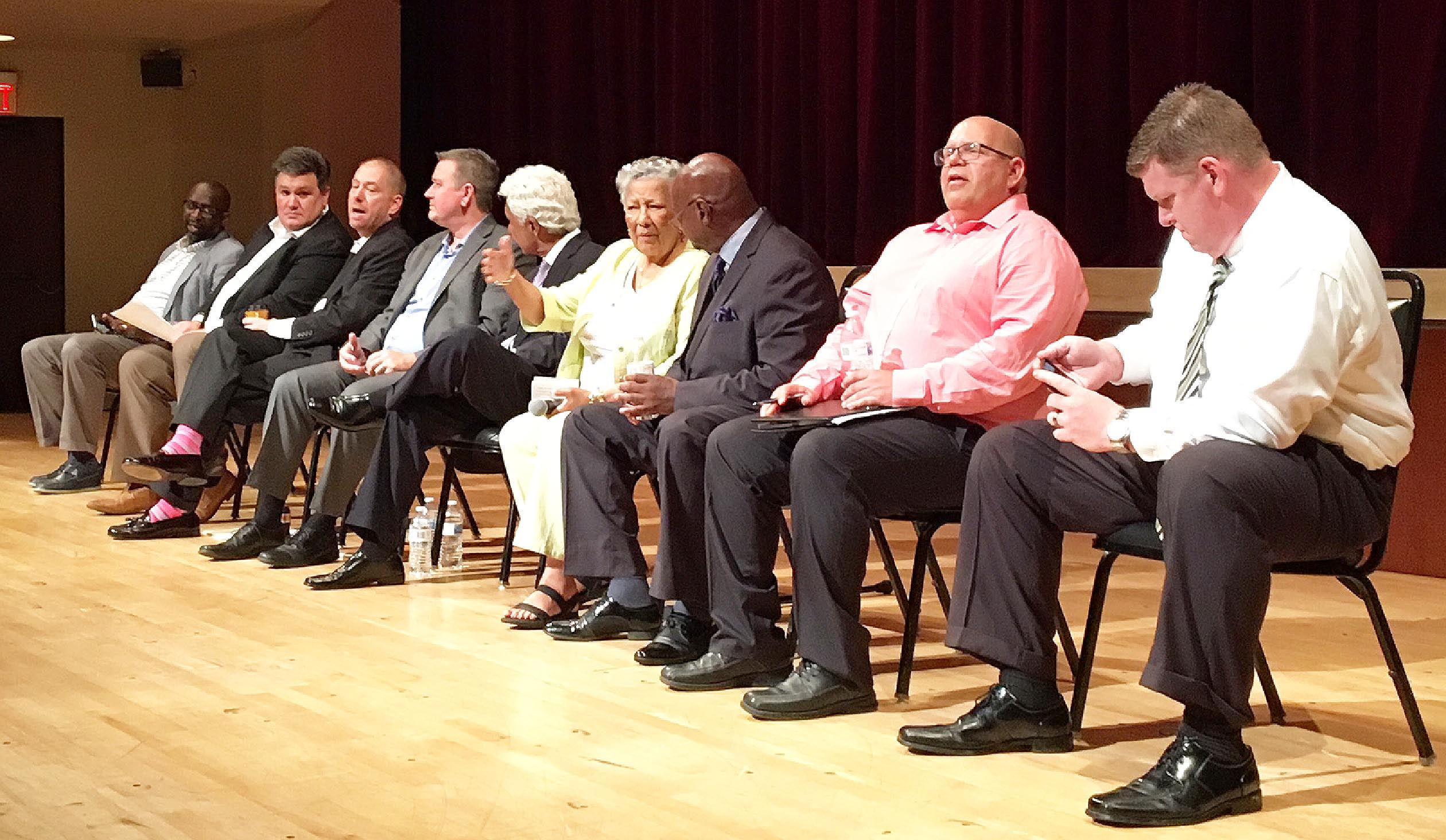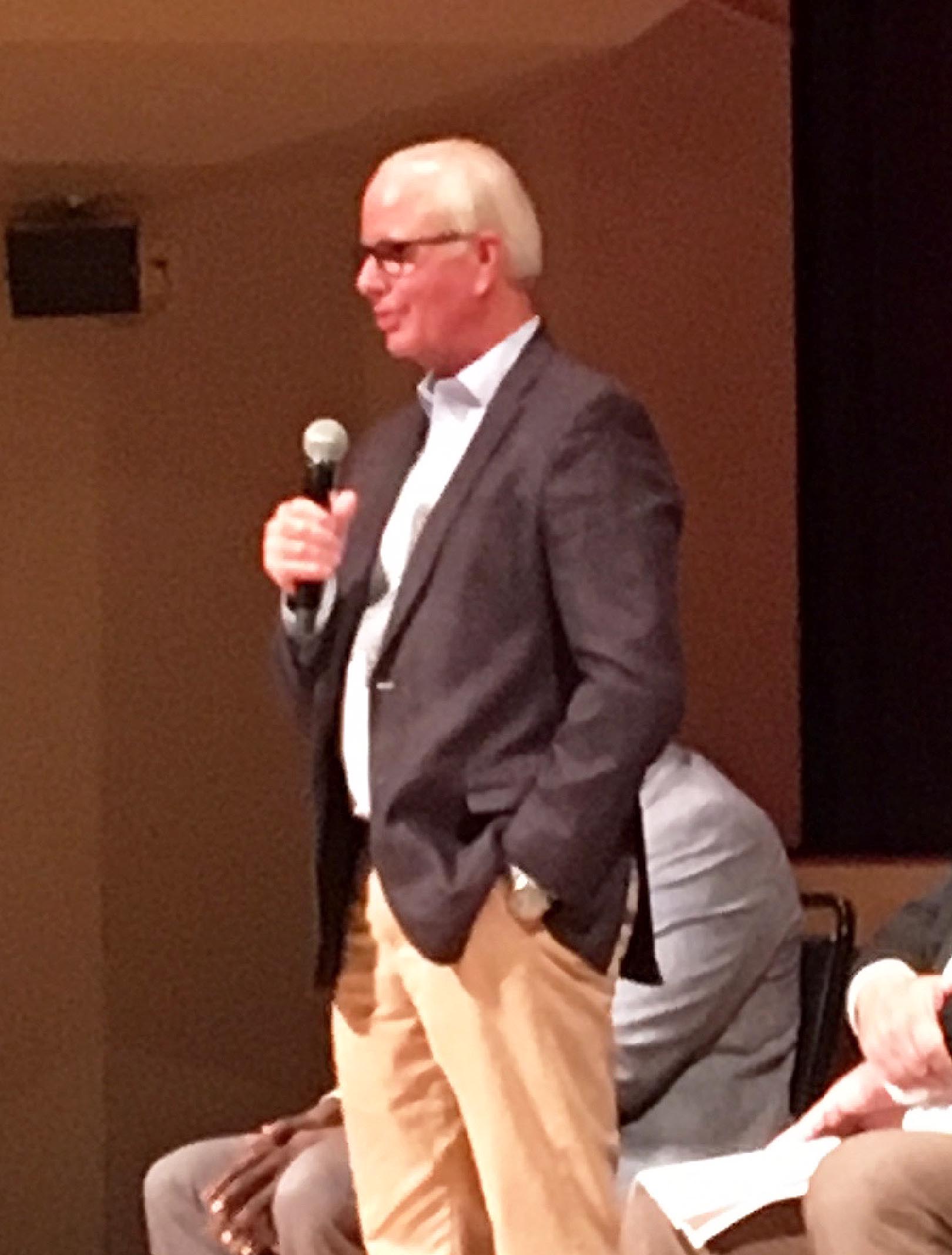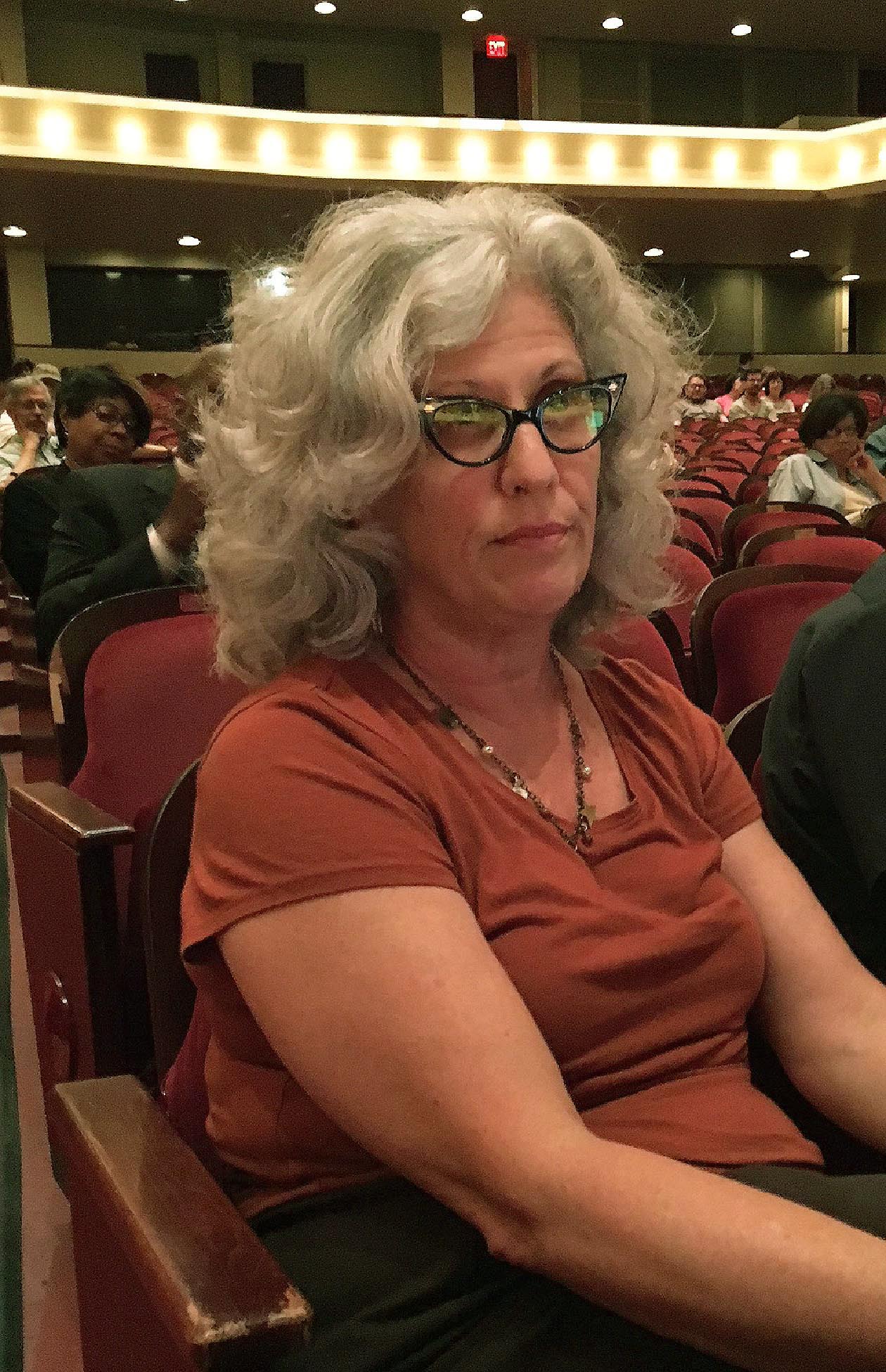By Jan Worth-Nelson
It seemed clear nobody in the audience for the second town hall on the proposed Arts Education and Cultural Enrichment millage up for a vote Aug. 7 was opposed to the arts.
Nina Jones Lewis, who moderated both panels, echoed several speakers in her concluding summary, “Yes, we’re poor and yes, we have bad water, but we have something to be proud of, and it is represented here. History has shown that the arts are lasting — these are things that inspire us, inspire our children, give our children hope, and our young people opportunities to fulfill their dreams.”
But the panel of nine arts executive lined up in harsh lighting on the stage of Whiting Auditorium before an audience of about 70 nonetheless faced a series of persistent questions.

Arts executives on arts millage panel (from left) Bryant Nolden, Mark Sinila, Jarret Haynes, Todd Slisher, Rodney Lontine, Moderator Nina Jones Lewis, Charles Winfrey, Tom Webber, Randall Thompson (Photo by Patsy Isenberg).
Residents pressed concerns about accountability for program decisions if the .96 millage passes: the “who, what, why, how and how much” of the proposal, which would generate about $8.7 million a year over 10 years for a dozen arts agencies county-wide.
They also called for greater gender diversity within top arts management and pushed for answers about the relationship between public funding if the millage passes and the new $35 million charter school, called the Flint Cultural Center Academy, on which ground was broken last month at the site of the former Sarvis Center.
As in the first town hall, the panel included Bryant Nolden, executive director of Berston Fieldhouse; Charles Winfrey, founder and executive director of the New McCree Theater; Rodney Lontine, president and CEO of the Flint Institute of Music which incorporates the Flint Symphony Orchestra, the Flint School of Performing Arts, and the Flint Youth Theater; Todd Slisher, executive director of the Sloan Museum/Longway Planetarium; John Henry, executive director of the Flint Institute of Arts; Jarret Haynes executive director of the Whiting Auditorium and Capitol Theater; Mark Sinila, CEO of the Flint Cultural Center Foundation; Tom Webber, president of the board of the Greater Flint Arts Council; and Randall Thompson, president of Citizens for a Better Genesee County, the volunteer group which originally proposed and has promoted the millage.

FIA Executive Director John Henry (Photo by Patsy Isenberg)
Slisher again reviewed the proposed allocations of funds to the recipient member institutions if the millage passes: $414,000 each per year to Berston Fieldhouse and the New McCree Theater; $500,000 a year to the Greater Flint Arts Council for regranting to other arts groups; and about $1.8 million each to the FIM, the FIA, the Sloan, and the Flint Cultural Center Foundation which is the administrative arm for the Cultural Center campus.
He also noted two percent of the revenue, about $193,000 a year, would go to local Downtown Development Authorities in the county — a distribution required by state law.
“I’ve been up here before,” John Henry of the FIA, said as the meeting began,” but I’ve never been under the bright lights” — a comment which drew smiles from the audience as several suggested the millage campaign should have been more transparent and anticipated and answered questions sooner.
Henry, who has been with the FIA for 23 years and recently guided it through a $14 million, 20,000-square foot expansion, went on to note this is the FIA’s 90th year of “nonstop service to the community” and to praise Flint’s “captains of industry” who decided to combine culture and education in the ’50s when the current Cultural Center on Kearsley Street was conceived.
Reaching out to underserved communities
But several speakers voiced concerns that the city’s cultural institutions have not always reached out adequately to underserved communities, and will need to aggressively do so if they are receiving millions of dollars of public funds.
Eastside neighborhood activist Tony Palladeno, a highly recognizable figure during the water crisis, spoke up for access to the arts from what he called “the forgotten rotten neighborhood of Flint” which literally begins just across Robert T. Longway from the Cultural Center.
“I was that second grader in the third row that never knew what an oboe was,” he said, recalling being exposed to the arts in elementary school. “I heard a kettle drum pounding for the first year in my heart — it still does it.”
But the public school arts programming when he was growing up–and in fact, the physical schools themselves, several speakers noted–have disappeared.
“Walker, Homedale,Whittier, Central — GONE,” Palladeno said. “You understand what I’m saying to you? But I was that kid in the second grade that got a piece of this–and this should be available to everybody.”

Tony Palladeno (Photo by Patsy Isenberg)
Still, Palladeno said he has concerns that as a group of private, non-profit institutions a push for adequate access for the public might not yet be second nature.
“You are looking at the city of Flint here,” he said. “I/we are Flint. I/we expect something for our children and our elderly. I get to look from a burned out neighborhood for not one year, not two years — twenty years ago we got abandoned. Not once has anybody from this building [The Whiting] come into that neighborhood.
“I am for this, just for the simple fact that you might bring the elderly in with the kids for somebody who never heard an oboe before,” Palladeno said.
Through a “memo of understanding,” a document not made public until just before the first town hall, many benefits of the millage revenue were detailed, featuring free admission to the FIA and Sloan, discounted admissions in several of the other institutions, discounted programs and discounted tickets for Whiting and Capitol Theater productions for Genesee County residents. They are detailed here.
But Palladeno warned, “If this millage passes and I come in here and see empty seats, you–all of you–have done something wrong, because you haven’t reached the people that you need to reach.”
Whiting Auditorim/Capitol Theater executive director Haynes agreed, saying, the arts in public schools haven’t just been cut, but “eviscerated.”
“What our institutions used to complement, we find ourselves increasingly supplementing what’s NOT there,” He said the answer was not to curse the darkness but to light a candle, and said the millage would be a powerful step to do just that.
Accountability for mission, money, and public input

Kate Scheid (Photo by Patsy Isenberg)
College Cultural neighborhood resident Kate Scheid said she and her husband have two children making their way in the arts, so “we understand,” Still, she said, as a library director who led three millage campaigns, “how I managed funds could be addressed by the public directly” and questioned, along with other commenters, if the current proposal adequately provide for that accountability.
She noted that because the millage covers 10 years, she worried that if missions changed or leadership attempted to take the arts institutions in different directions the public might not be adequately represented.
As had been explained at the first town hall, Randall Thompson emphasized that because the revenue funds will go through the Genesee County Board of Commissioners, the board, an elected body, would serve an auditing function–“taxpayer protection,” he called it, perhaps by adding more community representatives to arts boards or by appointing an arts ombudsman.
Flint attorney Terry Bankert, who had spoken at the first town hall too, urged consideration of making the memo of understanding, a “performance agreement” a contract that could be reviewed each year. Otherwise, he said, “this is a lot of real soft ‘trust us.”
“We don’t trust anybody in authority around here,” Bankert declared. “So if we’re going to ask a lot of questions, that’s just the way it is. I’m not talking about somebody stealing our money — I’m talking program accountability.”
Mott Foundation drawback a factor?
Asked if the millage proposal was prompted by planned drawing back of funding support from the Mott Foundation, Slisher said, “That is not true. The Mott Foundation is grant based, based on where they want to put their focus. It’s something we apply for every year.”
However, he added, “it is true that our donor base is fragile and shrinking.” The new tax laws have disincentives to charitable giving, he pointed out, facing arts organizations with the need to stabilize their funding so that services can be predictably continued for the next 20 years and beyond.”
Surveying the panel on stage, Kate Scheid said, “I am very disappointed that all of the representatives of these arts organizations are men.”
Palladeno agreed: “You need four women at least up in there busting some butt like my mom and grandmother and making you guys listen,” he said.
Charter school connections questioned, clarifications offered

Berston Fieldhouse executive director Bryant Nolden (Photo by Patsy Isenberg)
Responding to a question about whether the new Flint Cultural Center Academy was part of the plan–a school, one participant complained was part of “sucking the life out of Flint schools,” Haynes said a “broad requirement” from the beginning that “our involvement in the charter school was not going to detract from or reduce the services and programs that we already provide to students throughout Genesee County already, and that remains one of the hallmarks of our continued participation.
Also, Haynes noted, another criterion was that construction of the school would not begin until the project was fully funded. It was paid for almost entirely by a $35 million grant from the C.S. Mott Foundation announced several months ago, Todd Slisher noted.
There will be programs the students of the charter school will participate in, he said, but there is no direct use of any millage dollars for the operation and daily function of the charter school — that is an absolute certainty.”
Henry noted the FIA serves students from 11 counties and 30,000 students from Genesee County alone each year, compared to only 300 from the charter school–suggesting FIA’s proportional commitment would be to expanding, not limiting, services.
Citizens for a Better Genesee County financing questioned
Asked about who had paid a $2,500 late filing fee penalty for county documents for the Citizens for a Better Genesee County, Randall Thompson said he had personally covered it. The father of six, he said he was serving because he wants quality arts services for his children and for a better Genesee County. And “for the ninth time,” he said, he again stated he is not being paid for his services. Rumors have circulated about who is financing the millage campaign, whether there is an unnamed donor behind it, and why that would be a secret; Thompson only recently issued a list of about 25 people he said were part of the campaign committee.
In conclusion
“Thanks for holding us to account,” Slisher said in closing remarks. John Henry noted, “What you said is important for all of us to hear. We’re staying here for the long haul and we’re going to make it better. We see this city picking itself up, revitalizing itself every day. We’re one of the good stories.”
“We have jewels in Flint,” Moderator Lewis concluded. “These representatives have integrity and accountability, and they need your support to expand. I pray that you will vote for this millage and keep us alive and rich and growing.”
EVM Editor Jan Worth-Nelson can be reached at janworth1118@gmail.com.



You must be logged in to post a comment.